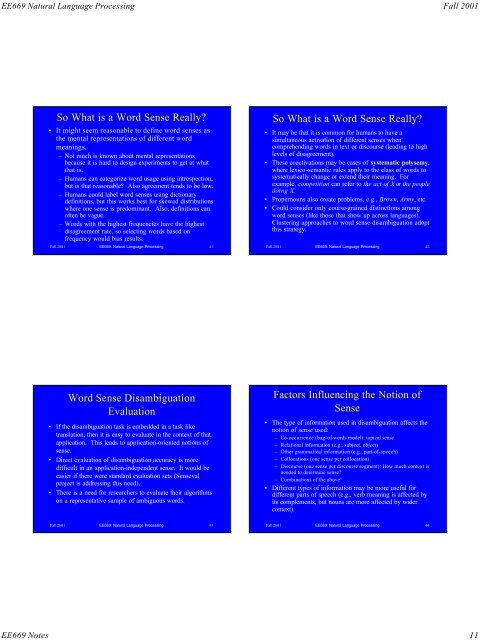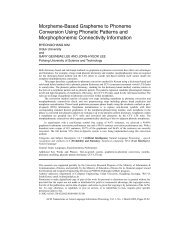Ch7. word sense disambiguation
Ch7. word sense disambiguation
Ch7. word sense disambiguation
You also want an ePaper? Increase the reach of your titles
YUMPU automatically turns print PDFs into web optimized ePapers that Google loves.
EE669 Natural Language Processing Fall 2001EE669 Notes 11So What is a Word Sense Really?• It might seem reasonable to define <strong>word</strong> <strong>sense</strong>s asthe mental representations of different <strong>word</strong>meanings.– Not much is known about mental representationsbecause it is hard to design experiments to get at whatthat is.– Humans can categorize <strong>word</strong> usage using introspection,but is that reasonable? Also agreement tends to be low.– Humans could label <strong>word</strong> <strong>sense</strong>s using dictionarydefinitions, but this works best for skewed distributionswhere one <strong>sense</strong> is predominant. Also, definitions canoften be vague.– Words with the highest frequencies have the highestdisagreement rate, so selecting <strong>word</strong>s based onfrequency would bias results.Fall 2001 EE669: Natural Language Processing 41So What is a Word Sense Really?• It may be that it is common for humans to have asimultaneous activation of different <strong>sense</strong>s whencomprehending <strong>word</strong>s in text or discourse (leading to highlevels of disagreement).• These coactivations may be cases of systematic polysemy,where lexico-semantic rules apply to the class of <strong>word</strong>s tosystematically change or extend their meaning. Forexample, competition can refer to the act of X or the peopledoing X.• Propernouns also create problems, e.g., Brown, Army, etc.• Could consider only course-grained distinctions among<strong>word</strong> <strong>sense</strong>s (like those that show up across languages).Clustering approaches to <strong>word</strong> <strong>sense</strong> <strong>disambiguation</strong> adoptthis strategy.Fall 2001 EE669: Natural Language Processing 42Word Sense DisambiguationEvaluation• If the <strong>disambiguation</strong> task is embedded in a task liketranslation, then it is easy to evaluate in the context of thatapplication. This leads to application-oriented notions of<strong>sense</strong>.• Direct evaluation of <strong>disambiguation</strong> accuracy is moredifficult in an application-independent <strong>sense</strong>. It would beeasier if there were standard evaluation sets (Sensevalproject is addressing this need).• There is a need for researchers to evaluate their algorithmson a representative sample of ambiguous <strong>word</strong>s.Factors Influencing the Notion ofSense• The type of information used in <strong>disambiguation</strong> affects thenotion of <strong>sense</strong> used:– Co-occurrence (bag-of-<strong>word</strong>s model): topical <strong>sense</strong>– Relational information (e.g., subject, object)– Other grammatical information (e.g., part-of-speech)– Collocations (one <strong>sense</strong> per collocation)– Discourse (one <strong>sense</strong> per discourse segment): How much context isneeded to determine <strong>sense</strong>?– Combinations of the above• Different types of information may be more useful fordifferent parts of speech (e.g., verb meaning is affected byits complements, but nouns are more affected by widercontext).Fall 2001 EE669: Natural Language Processing 43Fall 2001 EE669: Natural Language Processing 44



